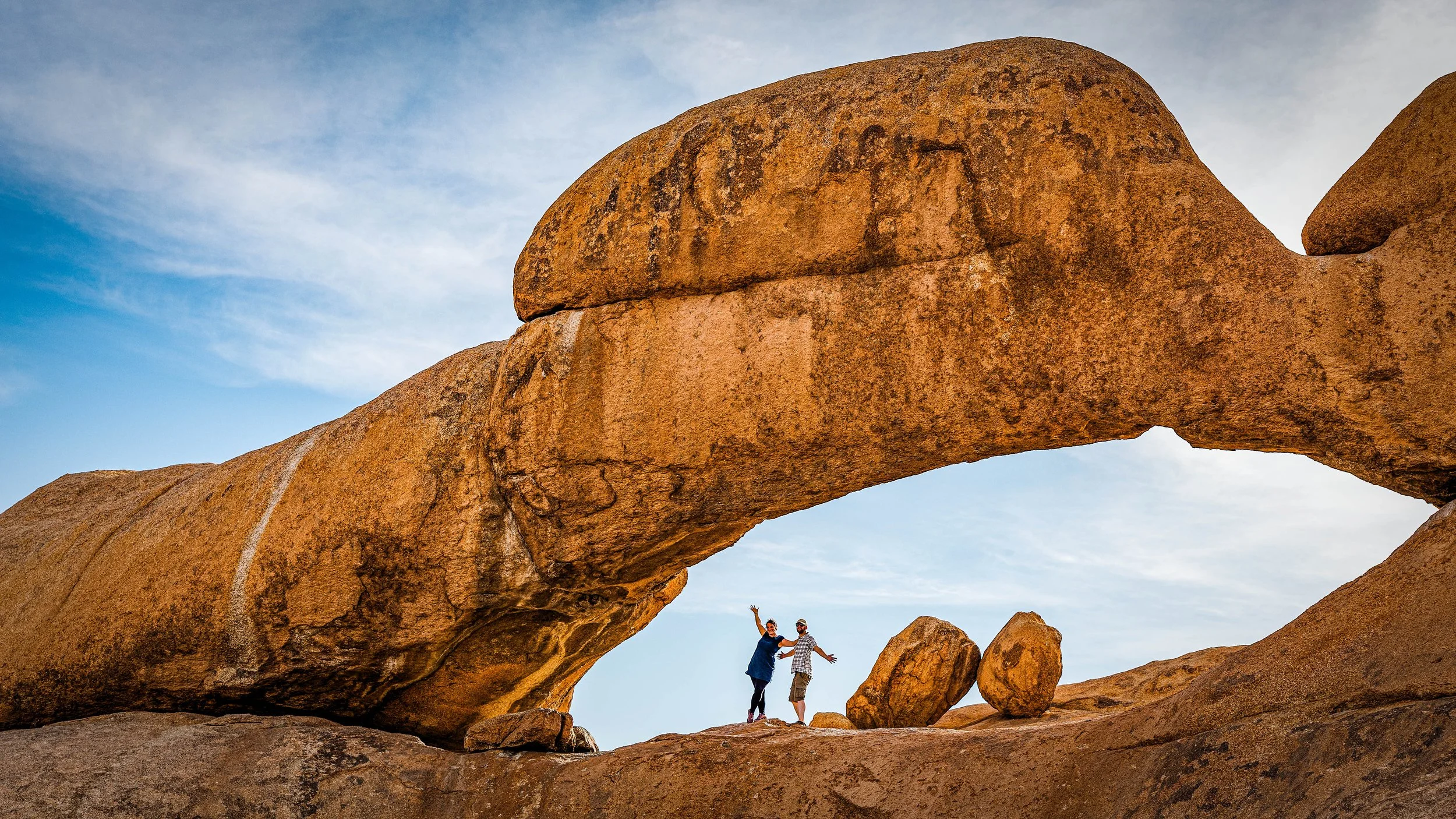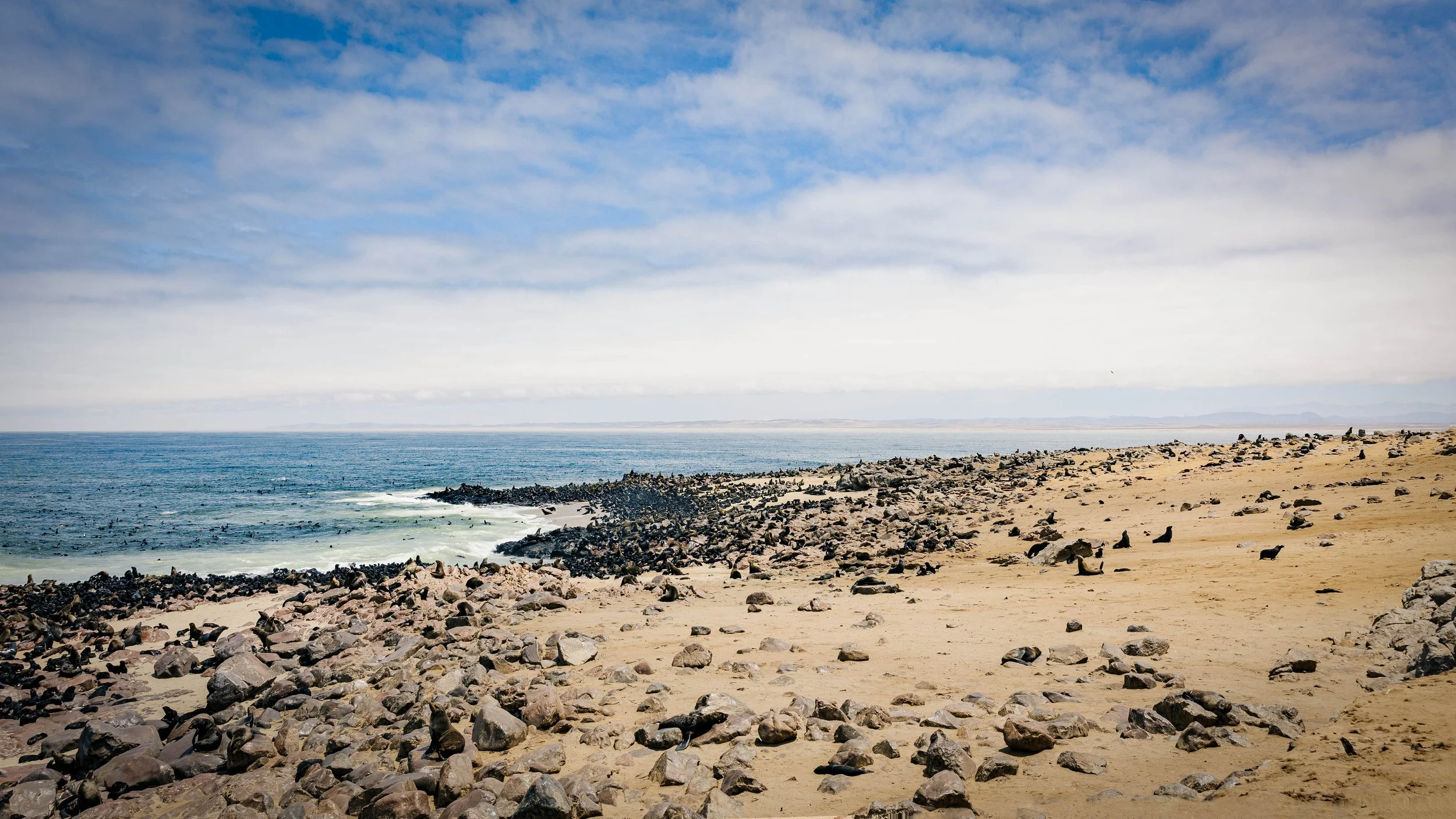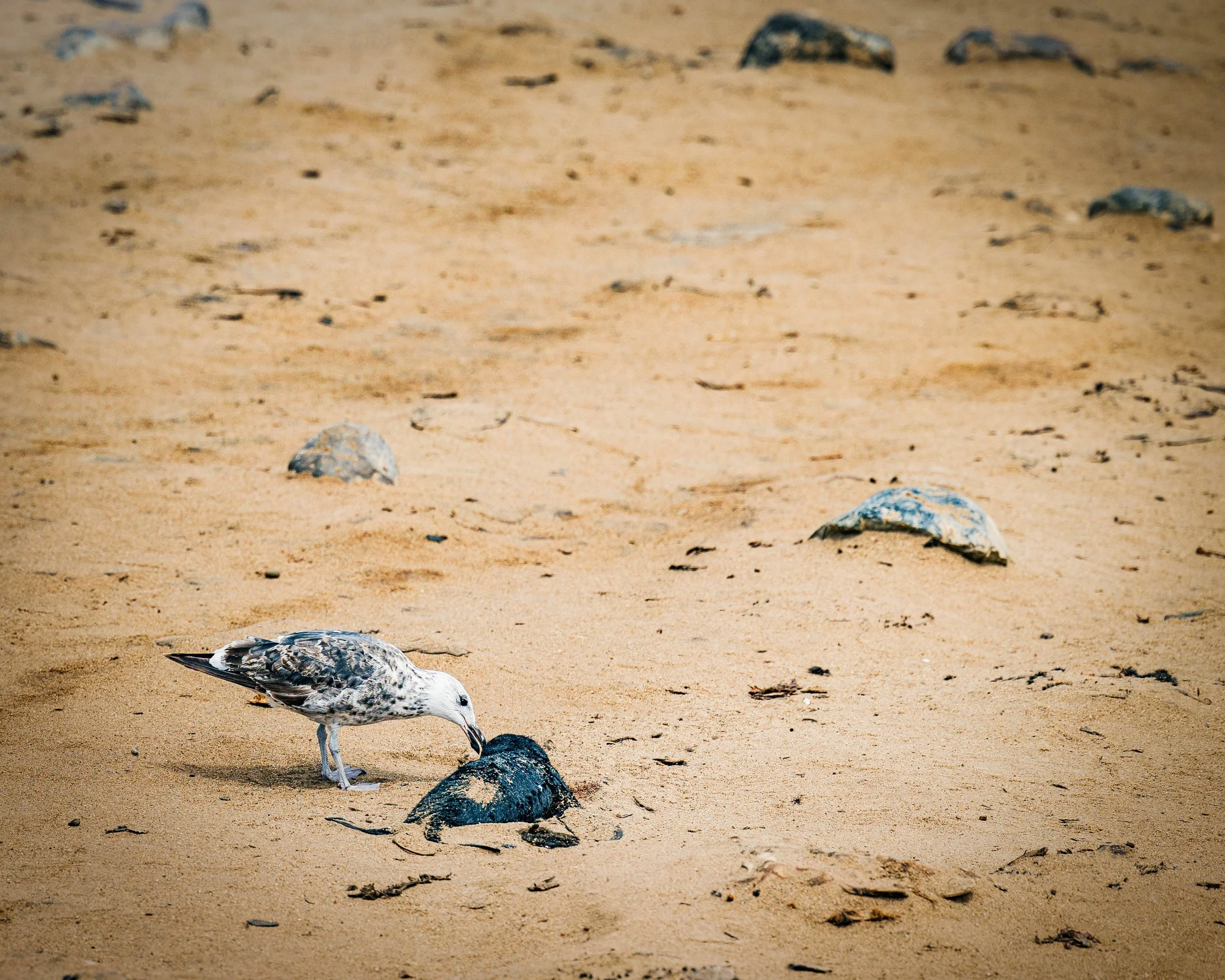Namibia - Spitzkoppe and Swakopmund
Travelling further south west we enter the desert. Leaving the small town of Outjo the tarmac road we had briefly since Etosha disappears, the trucks huge tyres crest the corrugated dirt road at speed. Our first stop in the desert is at Spitzkoppe, a granite mountain where we have a desert camp for the night.
As the sun sets we walk towards a rocky outcrop for a better view. There are rock hyrax here, they scamper from the burrows and climb up the thorny acacias, tumbling often I mistake them for lemmings. Martina takes photos of them but one young hyrax tumbles from a branch trapping its front paw between thorns. It plays dead hanging from the tree. Martina tries to lower the branch to the floor to allow it to escape, it can’t and squeals, struggling, twisting its paw more into the thorns. We rush back to camp to get help and something to cut the branches away. John and Erellah rush back with us, armed with a kitchen knife, they are able to free the thorns clamping its paw and release it. It scampers off up the rock to join the rest of the family.






























The sun sets in the desert, casting red hues over the rocky outcrops, and as the light fades the desert quickly cools. The smell of cooking on coals beckons us back to camp and we enjoy steak and potatoes by a camp fire. Erellah delivers a lengthy monologue on Namibian history, politics, geology, and the animals of the desert. The cloudless sky darkens and is replaced by a blanket of shining stars. I trace the stars and for once I can see the patterns with all the missing pieces. The Milky Way shimmers with a billion pinpricks of light. Despite lugging a small tripod with us, Martina struggles to get a clear photo with her camera, I take a ten second iPhone photo as a backup. The night is cold in the desert, wrapped up in the morning we have breakfast by the small campfire. There are ancient rock paintings from the San people and a local guide explains the paintings to us, we hold a blanket to provide shade from the morning sun to see the faint paintings. She teaches a few sounds from the Nama and Damara tribes click language which is similar to the San bushman that painted the rocks, she manages to get us to say good morning and I love you.
People have asked Martina how we are camping in Africa and so she put together a little photo selection for you. Now and then we leave the tent in the truck and take an upgrade option if we need a good nights rest, or when it was raining heavily. Often it’s a worthwhile upgrade, especially in Namibia, the rooms may be a little more expensive but usually comfortable and clean.












As we leave Spitzkoppe our fellow Swiss German explorers compare the rocky peaks to the mountain tops at home. Spitzkoppe is also known as the Matterhorn of Africa, it’s similar in shape and very difficult to climb. The Swiss reminisce of the foods they miss from home, laugengipfeli I’ll give them but the cervelat sausage they can keep for themselves!
There is cause for a small celebration as we head further through the desert, we can see the sea, and with that after a month on the road, we have traversed Africa.
















The pictures don’t do the stench justice. Cape Cross has a large seal colony and the pup season peaked a couple of weeks ago. The seal pups bleat like lambs and the older seals burble, snort and scream like drunk men in a bar fight. Erellah says the smell comes from a mixture of seal excrement, regurgitated sea food and the dead seal pups that litter the beach. Visitors escape back from the raised boardwalk with T shirts held over their noses, we don’t stay too long either. “Grusig!” exclaims Martina as Evelyn proffers menthol to sniff. The truck races away again, windows open to clear the air, stopping again a short distance away for lunch break but no one is really hungry, the smell of the seals still lingers.
Swakupmund is our base for the next three nights, it’s good to be able to stop for a little while, and we are dropped off directly at the local booking agents. The truck crew are going to have a well deserved short break from us and we can sort out our own arrangements for the next few days entertainment. We’re still not up for skydiving, skipping over the quad biking and paragliding we opt to go on the fat bikes over the dunes and a 4x4 adventure to the far remote dunes to Sandwich Bay. The latter said it was a photographer’s dream so that sold it really.








The town of Swakupmund seems a little odd, all the street names are German, named after the Kaiser or perhaps other imperial German figures, many of the restaurants are also German. Some of the bland street facing buildings hide colourful courtyards, there streets are wide, far too wide for the small town and little traffic. Perhaps in the early 1900’s the town planners had grand designs for a city. There is a lot of history in Namibia with the Germans, the lady at the old Buchhandlung has many texts from the colonial period, chatting in German she very proudly shows Martina the old books she has. I don’t ask about the genocide of the Nama and Herero people. The wind has changed here in the last week, the warm waters causing an algae bloom and die off, giving the town a distinctive odour. The native old name for the Swakup river means effluent or excretion and at the moment, Martina thinks the town smells like it.
Hanjo drops the fat bike and shoves his hands deep into the sand on the side of the dune. He’s searching for a slow worm, a limbless snake like reptile, there are many tracks in the sand where they have passed. This is his fifth attempt, so far he has found a chameleon, a sidewinder snake, a Namibian dune gecko and a shovel snouted lizard, but the slow worm continues to elude him.



























We started the trip with just the two of us and our guide Hanjo for a short scenic bike tour but upgraded to a longer desert wildlife tour, and naturally so Martina can take more photos. The fat bikes feel cumbersome on the road but come into their own in the desert sand. Their balloon like tyres floating on the loose surface, till we get to the deep sand, and then it’s hard work to keep the bike moving. He had spoken in German for the first half of the tour before remembering to switch back to English for me. He spots a lighter patch of sand and blows it to uncover a spiderweb, this particular spider hides in a hole and has a lid covering it, it can feel the vibrations of different insects and then either hide or pounce. Hanjo tells us of a wasp that will hunt for the spider, probing the surrounding sand and digging down till it finds the spider, they will then fight. If the spider wins, it will eat the wasp, if the wasp wins she will paralyse the spider, laying her eggs for a fresh meal for her larvae to eat alive.
Martina gives a whoop of joy as she descends over the crests of the dunes, we begin to head back towards the town, but not before Hanjo tries one more time to capture a slow worm. Foiled again, we ride further along the shoreline, past washed up dead sea life that have fallen victim to the change of currents. As we enter town, he points out his favourite places for food and coffee. We bid him farewell and head to the village cafe he had recommended. With a brightly painted courtyard, adorned with bacon themed posters, we receive large platefuls of food. It’s good, especially the bacon, surely we won’t need dessert..
Victor is keen to get going, there is only a short window in which the tide is low enough to reach Sandwich Bay, and the booking agent didn’t give us the correct time. I’d had a call from her and had to run back from town after making a reservation in a restaurant Hanjo recommended the day before. Victor is also a German speaking Namibian and we flow between speaking English and German as we drive down towards the big dunes. As we pass through Walvis Bay, here the street names are all in English as this deep sea port was annexed by the British. Huge container ships queue for the docks out at sea as Martina takes photos of the flamingos wading just off the beach. There are salt pans further along, where sea salt is harvested for industry and the table. The salt concentrate is bright pink in the morning sunshine.




















Driving further south along the sandy beach there is one section that can be particularly difficult, Victor says he has to be cautious and stay within the tracks where it is safe. He stops and walks a short distance from the car and scuffs the sand. There’s a tough thin crust on the sand but below it is wet and sticky, go off line here and there is no getting out again. As we get closer to sandwich bay there is a narrow section to drive between the sea and the big sand dunes, here sixteen cars have been lost to the waves in the last ten years. He shows us photos of one from last year from an experienced guide who got stuck, a crumpled wreck, little salvageable. He says Top Gear once filmed here and we promise to find it when we can. There are a few dead seals along the beach “seagulls, they can be quite evil” Victor points to the birds, “they pick their eyes out and they die”. We pass more seals and they barely seem to notice the car, “they’ve still got their eyes, just sleeping.” He turns the land cruiser up over a dune, descending slowly before gunning the V8 up to crest the next bigger dune. He’s clearly enjoying himself, and us too, grinning broadly as we near the top of the big dune overlooking sandwich bay. It takes its name from a corned beef factory that was once here, beef transported by mule along the beach to be canned in this isolated place. It’s all now a protected park, and a fence marks the end point where vehicles without special concessions can travel. Victor drives down the dune to park there as we walk down the steep dune towards the sea, digging our heels in to the soft sand to keep our balance. He has a small picnic table up and a selection of food he picked up on the way, it’s good though we don’t have long to chat. The tide is rising and Victor wants to get through the gap between the sea and dunes before it disappears.

